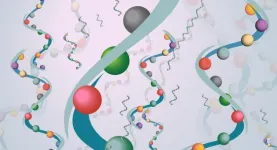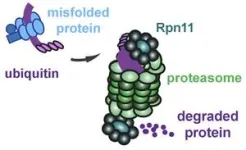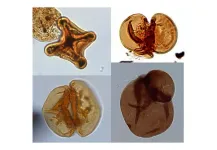(Press-News.org) Proteins are the workhorses of life. Organisms use them as building blocks, receptors, processors, couriers and catalysts. A protein’s structure is critical to its function. Malformed proteins not only fail to carry out their tasks, they can accumulate and eventually gum up the inner workings of cells. As a result, misfolded proteins cause a variety of degenerative diseases, from Alzheimer’s and Parkinson’s to the blinding disease retinitis pigmentosa. These disorders are currently incurable.
A paper out of UC Santa Barbara reveals a new connection between a particular ion transport protein and the cell’s garbage disposal, which grinds up misfolded proteins to stave off their toxic accumulation. The results, published in Developmental Cell, identify a target for treating these debilitating conditions.
“By studying basic cell biology in fruit fly ovaries, we stumbled upon a way to prevent neurodegeneration, and we think this has potential applications in the treatment of some human diseases,” said senior author Denise Montell, Duggan Professor and Distinguished Professor in the Department of Molecular, Cellular, and Developmental Biology.
For 35 years, Montell’s lab has studied the movement of cells in fruit fly ovaries. It might seem esoteric, she is the first to admit, but it provides a fantastic model for cell mobility. “And cell movement underlies embryonic development, drives wound healing and contributes to tumor metastasis,” she explained. “So it’s a really fundamental cell behavior that we care to understand deeply.”
The setting and characters
The star of this paper is a gene called ZIP7, which encodes a protein of the same name. In previous work, Montell’s team came across a mutation in this gene that impaired cell mobility, piquing their interest.
The ZIP7 protein ferries zinc ions within a cell. These ions are exceedingly rare within the cytoplasm but abundant in proteins where they often form part of the architecture and catalyze chemical reactions. “ZIP7 is conserved in evolution from plants to yeast to flies to humans,” Montell said. “So it’s doing something really fundamental, because it’s been around for a really long time.”
ZIP7 is also the only zinc transporter found in the endoplasmic reticulum, a membranous structure where a cell makes proteins destined for the outer membrane of the cell or for secretion out of the cell. About a third of our proteins are made here.
If ZIP7 is our protagonist, then misfolded proteins and their disposal are the theme of the study. For proteins, function follows form. It’s not enough to have the right ingredients, a protein must fold correctly to function properly. Misfolded proteins are responsible for a host of diseases and disorders.
But proteins will sometimes misfold even in a healthy cell. Fortunately, cells have a quality control system to deal with this eventuality. If the error is small, the cell can try folding it again. Otherwise, it will tag the misfolded molecule with a small protein called ubiquitin and send it out of the endoplasmic reticulum (ER) for recycling.
Waiting in the cytoplasm are structures called proteasomes, the “garbage disposals” of the cell. “It literally chews up the protein into little pieces that can then be recycled,” Montell said.
“But if the garbage disposal gets overwhelmed — somebody puts too many potato peels in there — then the cell experiences ER stress.” This triggers a response that slows down protein synthesis (pauses our potato prep) and produces more proteasomes so that the system can clear the backlog of waste. If all this fails, the cell undergoes programmed death.
The plot thickens
Co-lead author Xiaoran Guo, Montell’s former Ph.D. student, saw that loss of ZIP7 caused ER stress in the fruit fly’s ovary. So she set out to determine if this stress was the reason the cells lost their mobility. Indeed, inducing ER stress with a different misfolded protein also impaired cell migration.
When Guo over-expressed ZIP7 in these cells, the backlog of misfolded proteins disappeared, the ER stress vanished, and the cells regained their mobility. “I was so surprised that I had to question myself if I had done everything correctly,” Guo said. “If this was real, just ZIP7 alone must be very potent in resolving ER stress.”
What’s more, the misfolded protein she used, called rhodopsin, contains no zinc in its structure. This led Guo to suspect that ZIP7 must be involved somewhere in the degradation pathway. Co-lead author, and fellow doctoral student, Morgan Mutch used a drug to block the proteasome from degrading misfolded rhodopsin and observed that this negated the beneficial effect of ZIP7. She concluded that ZIP7 must be acting somewhere before the proteasome munches up the misfolded protein.
The authors created four modified ZIP7 genes: two mutations disrupted the protein’s ability to carry zinc, while the other two left this unchanged. They discovered that zinc transport was critical in reducing ER stress.
At this point, a new character enters our story: the enzyme Rpn11, which forms part of the proteasome. Much like trying to stuff a large head of broccoli down the disposal, misfolded proteins with ubiquitin tags don’t fit into the proteasome. Rpn11 snips off these tags, enabling the misfolded protein to slip into the proteasome core for disassembly. Zinc is essential forRpn11 to catalyze the removal of ubiquitin.
“I was very surprised, and then excited, when I saw that increasing ZIP7 expression almost completely prevented the buildup of those ubiquitin-tagged proteins,” Mutch said. “We were expecting the opposite result.”
Mutch determined that ZIP7 was critical in supplying zinc to Rpn11, enabling it to trim the tags that label defective proteins so that they fit into the structure that actually breaks them down. Blocking the Rpn11 enzyme confirmed this hypothesis.
“That feeling when you discover something new, something no one has figured out before, is the best feeling for a scientist,” Mutch added.
A potential therapy
The results suggest that overexpressing ZIP7 could form the basis for treating a variety of diseases. For instance, misfolded rhodopsin causes retinitis pigmentosa, a congenital blinding disease that is currently untreatable. Scientists already have a strain of fruit flies with the mutation that causes a similar disease, so the team overexpressed the ZIP7 gene in these flies to see what would happen.
“We found that it prevents retinal degeneration and blindness,” Montell said. Every single one of the flies with mutant rhodopsin usually develops retinitis pigmentosa, but a full 65% of those with overactive ZIP7 formed eyes that respond normally to light.
Montell’s lab is now collaborating with Professor Dennis Clegg, also at UC Santa Barbara, to further investigate the effect of ZIP7 in human retinal organoids, tissue cultures that bear a mutation that causes retinitis pigmentosa. This project was originally funded by the National Institute for General Medical Sciences. For the next three years it will be supported by a $900,000 grant from the Foundation Fighting Blindness so Montell, Clegg and their colleagues can test the hypothesis that ZIP7 gene therapy will prevent blindness in retinitis pigmentosa patients.
What’s more, proteasome capacity declines as we get older, contributing to many classic signs of aging and increasing the probability of age-related degenerative diseases. Therapies targeting ZIP7 could potentially slow the development or progression of these ailments, as well. They’ve already yielded promising results extending fruit fly lifespan.
“This is a poster child for fundamental, curiosity-driven research,” Montell said. “You’re just studying something because it’s cool, and you follow the data and end up discovering something you never set out to study, possibly even a cure for multiple diseases.”
END
Researchers reveal a new approach for treating degenerative diseases
Insights on the proteasome reveal a therapy target for misfolded protein diseases
2024-04-30
ELSE PRESS RELEASES FROM THIS DATE:
People who inject drugs are transitioning to smoking
2024-04-30
Researchers from the University of California San Diego have revealed new trends in drug consumption that shed light on how people are adapting to the evolving risks associated with unregulated drug use in the United States. The findings could help policymakers and public health officials better tailor interventions to meet the needs of vulnerable populations and reduce the public health burden of substance-related harm.
Since the early 2010s, deaths from accidental overdoses have been on the rise ...
AI speech analysis may aid in assessing and preventing potential suicides, says Concordia PhD candidate Alaa Nfissi
2024-04-30
Speech is critical to detecting suicidal ideation and a key to understanding the mental and emotional state of people experiencing it. Suicide hotline counsellors are trained to quickly analyze speech variation to better help callers through a crisis.
But just as no system is perfect, there is room for error in interpreting a caller’s speech. In order to assist hotline counsellors to properly assess a caller’s condition, Concordia PhD student Alaa Nfissi has developed a model for speech emotion recognition (SER) using artificial intelligence tools. The model analyzes and codes waveform modulations in ...
New clinical practice guideline provides evidence-based recommendations for Age-related Hearing Loss (ARHL)
2024-04-30
April 30, 2024, ALEXANDRIA, Virginia —The American Academy of Otolaryngology–Head and Neck Surgery Foundation (AAO-HNSF) published the Clinical Practice Guideline: Age-Related Hearing Loss today in Otolaryngology–Head and Neck Surgery. This clinical practice guideline (CPG) sheds lights on a global public health problem affecting approximately 466 million people worldwide and identifies quality improvement opportunities and provide clinicians trustworthy, evidence-based recommendations regarding the identification and management of age-related hearing loss (ARHL) in patients 50 years and older.
“Age-related ...
Low-intensity grazing is locally better for biodiversity but challenging for land users, a new study shows
2024-04-30
The grazing of both domestic and wild animals is shaping landscapes across Europe. It can also contribute to multiple ecosystem services, such as providing habitat for biodiversity. Grazing systems with lower densities of animals and with minimal and only targeted applications of deworming and other medicinal treatments offer benefits for local biodiversity protection and various ecosystem services. However, this type of land management also poses a range of challenges, leading to a constant decline in the number of land users engaged in low-intensity grazing. A team of researchers led by iDiv, UL, and UFZ set out to investigate these ...
An omega-6 fatty acid may reduce the risk for bipolar disorder
2024-04-30
Philadelphia, April 30, 2024 – A genetic propensity to higher circulating levels of lipids containing arachidonic acid, an omega-6 polyunsaturated fatty acid found in eggs, poultry, and seafood, has been found to be linked with a lower risk for bipolar disorder, according to a new study in Biological Psychiatry, published by Elsevier. This new evidence paves the way for potential lifestyle or dietary interventions.
Bipolar disorder is a debilitating mood disorder characterized by recurring episodes of mania and depression. Although its etiology is still unclear, previous studies have shown that ...
New breast cancer screening recommendations aim to address health inequities, especially among Black women
2024-04-30
In an effort to improve early detection of breast cancer and address disparities in outcomes, the US Preventive Services Task Force (USPSTF) has issued updated breast cancer screening recommendations to now advise all women to undergo routine screening every other year starting at age 40 —representing a significant shift from previous guidelines, which recommended screening starting at age 50 and engaging in individualized decision-making for women aged 40 to 49.
The revised guidelines aim to enhance early detection of breast cancer and tackle disparities in breast cancer mortality, particularly among Black women, who are more likely to have aggressive ...
AGS honors expert and emerging geriatrics leaders at 2024 virtual annual scientific meeting (#AGS24)
2024-04-30
New York (April 30, 2024) – The American Geriatrics Society (AGS) annually honors researchers, clinicians, educators, and emerging health professionals who have made outstanding contributions to high-quality, person-centered care for older adults. This year’s award recipients include 19 leaders representing the breadth of medical disciplines championing care for us all as we age.
Choosing Wisely Champion Award
Paras Goel, PT, DPT, Med, MBA, GCS
Clinical Student Research Award
Elizabeth Margaret Ann Kelly
Clinician of the Year Award
Joyce Fogel, MD
David ...
Protecting endangered monkeys from poachers, habitat loss
2024-04-30
COLUMBUS, Ohio – The Tai Forest Monkey Project has operated a research field station in west Africa’s Ivory Coast for 30 years, but on the one day since its opening that the site was unstaffed because of conflict in nearby Liberia, poachers took advantage – and killed 18 endangered monkeys.
The anecdote is a telling example, scientists say, of how thousands of field stations studying primates in forests around the world not only generate knowledge about these threatened species, but also contribute to ...
China’s bid to decarbonize may have hidden costs
2024-04-30
ITHACA, N.Y. – Environmentalists rejoiced when China announced its commitment to reach carbon neutrality by 2060, but the decarbonization of China – which emits 27% of global carbon dioxide and a third of the world’s greenhouse gases – may come with hidden costs and hard environmental choices, according to new research.
In a paper published in Communications Earth & Environment, Stefano Galelli, associate professor at Cornell University’s School of Civil and Environmental Engineering, and colleagues attempt to quantify how decarbonizing the China Southern Power Grid, which provides electricity ...
Climate change and mercury pollution stressed plants for millions of years
2024-04-30
The link between massive flood basalt volcanism and the end-Triassic (201 million years ago) mass-extinction is commonly accepted. However, exactly how volcanism led to the collapse of ecosystems and the extinction of entire families of organisms is difficult to establish. Extreme climate change from the release of carbon dioxide, degradation of the ozone layer due to the injection of damaging chemicals, and the emissions of toxic pollutants, are all seen as contributing factors. One toxic element stands out: ...
LAST 30 PRESS RELEASES:
Researchers identify gene that calms the mind and improves attention in mice
Artificial metabolism turns waste CO2 into useful chemicals
Ancient sea anemone sheds light on animal cell type evolution
Begging gene leads to drone food
How climate policies that incentivize and penalize can drive the clean energy transition
Can community awareness campaigns in low-resource areas improve early diagnosis of colorectal cancer?
Stardust study resets how life’s atoms spread through space
Practical education: Clinical scenario-based program development
The impact of family dynamics on eating behaviour – how going home for Christmas can change how you eat
Tracing the quick synthesis of an industrially important catalyst
New software sheds light on cancer’s hidden genetic networks
UT Health San Antonio awarded $3 million in CPRIT grants to bolster cancer research and prevention efforts in South Texas
Third symposium spotlights global challenge of new contaminants in China’s fight against pollution
From straw to soil harmony: International team reveals how biochar supercharges carbon-smart farming
Myeloma: How AI is redrawing the map of cancer care
Manhattan E. Charurat, Ph.D., MHS invested as the Homer and Martha Gudelsky Distinguished Professor in Medicine at the University of Maryland School of Medicine
Insilico Medicine’s Pharma.AI Q4 Winter Launch Recap: Revolutionizing drug discovery with cutting-edge AI innovations, accelerating the path to pharmaceutical superintelligence
Nanoplastics have diet-dependent impacts on digestive system health
Brain neuron death occurs throughout life and increases with age, a natural human protein drug may halt neuron death in Alzheimer’s disease
SPIE and CLP announce the recipients of the 2025 Advanced Photonics Young Innovator Award
Lessons from the Caldor Fire’s Christmas Valley ‘Miracle’
Ant societies rose by trading individual protection for collective power
Research reveals how ancient viral DNA shapes early embryonic development
A molecular gatekeeper that controls protein synthesis
New ‘cloaking device’ concept to shield sensitive tech from magnetic fields
Researchers show impact of mountain building and climate change on alpine biodiversity
Study models the transition from Neanderthals to modern humans in Europe
University of Phoenix College of Doctoral Studies releases white paper on AI-driven skilling to reduce burnout and restore worker autonomy
AIs fail at the game of visual “telephone”
The levers for a sustainable food system
[Press-News.org] Researchers reveal a new approach for treating degenerative diseasesInsights on the proteasome reveal a therapy target for misfolded protein diseases




